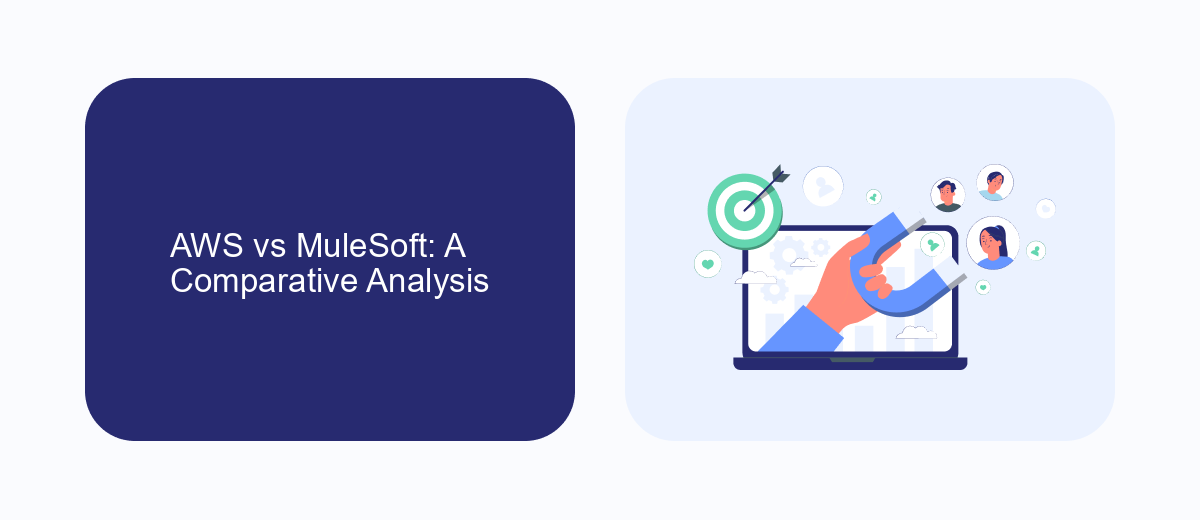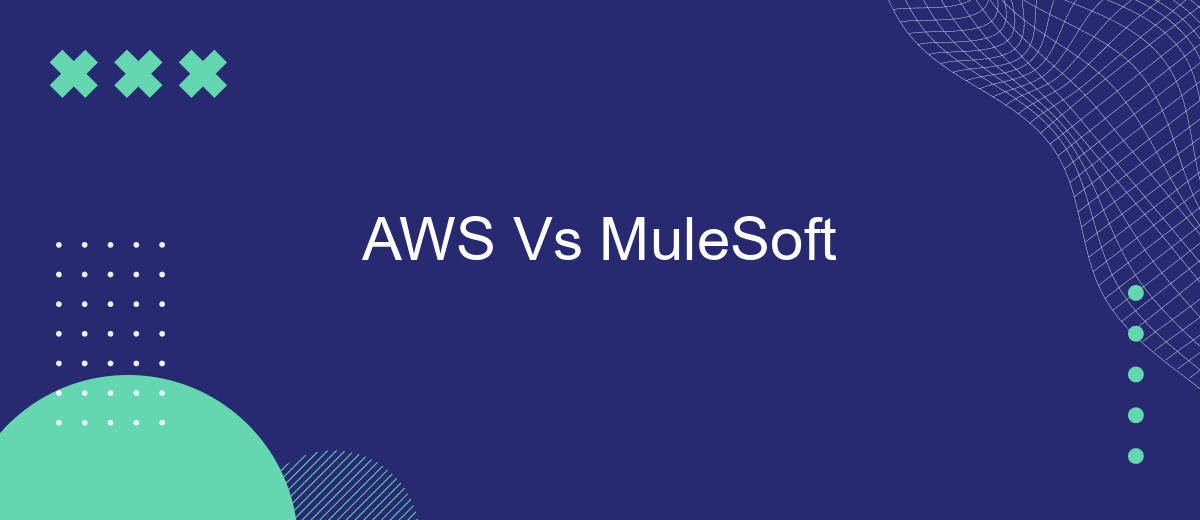In today's rapidly evolving digital landscape, businesses are increasingly relying on robust integration platforms to streamline their operations and enhance connectivity. AWS (Amazon Web Services) and MuleSoft are two leading solutions in this domain. This article delves into a comparative analysis of AWS and MuleSoft, exploring their features, strengths, and use cases to help you make an informed decision.
Introduction
In today's rapidly evolving digital landscape, businesses are constantly seeking efficient ways to integrate various applications and services. Two prominent solutions for achieving seamless integration are AWS (Amazon Web Services) and MuleSoft. Both platforms offer robust tools and capabilities, but they cater to different needs and use cases, making it essential to understand their distinct features and benefits.
- AWS provides a comprehensive suite of cloud services, including computing power, storage, and databases, enabling businesses to build and scale applications effortlessly.
- MuleSoft, on the other hand, specializes in API-led connectivity, offering tools like Anypoint Platform to design, build, and manage APIs and integrations across various systems.
- For businesses looking for a more streamlined approach to integration, services like SaveMyLeads can automate the process of connecting different applications without the need for extensive coding or technical expertise.
Understanding the strengths and unique offerings of AWS and MuleSoft is crucial for making an informed decision on which platform best suits your organization's integration needs. This article will delve into the key differences, advantages, and potential use cases for each, helping you navigate the complexities of modern integration solutions.
AWS vs MuleSoft: A Comparative Analysis

Amazon Web Services (AWS) and MuleSoft are two prominent players in the realm of cloud computing and integration platforms. AWS is renowned for its comprehensive suite of cloud services, including computing power, storage, and databases, which cater to a wide array of applications. It offers robust scalability, security, and flexibility, making it a preferred choice for enterprises looking to build and deploy applications in the cloud. On the other hand, MuleSoft specializes in integration solutions, providing tools to connect various applications, data, and devices. Its Anypoint Platform is highly regarded for its ability to streamline API management and integration processes.
When comparing AWS and MuleSoft, the choice largely depends on the specific needs of an organization. AWS excels in providing a broad range of cloud services, ideal for businesses aiming to migrate to the cloud or enhance their existing infrastructure. MuleSoft, however, is exceptional for organizations focusing on seamless integration across multiple systems. For instance, services like SaveMyLeads can complement MuleSoft by automating lead data integration, ensuring smooth and efficient workflows. Ultimately, the decision should be based on whether the primary requirement is cloud infrastructure or sophisticated integration capabilities.
Feature Comparison

When comparing AWS and MuleSoft, it's crucial to consider their features to determine which platform best suits your business needs. Both platforms offer robust solutions for cloud services and integration, but they have distinct functionalities that cater to different requirements.
- Integration Capabilities: AWS provides a range of services like AWS Lambda, API Gateway, and Step Functions for building and managing integrations. MuleSoft, on the other hand, offers a dedicated integration platform with pre-built connectors and tools for seamless connectivity.
- Scalability: AWS excels in scalability with its vast infrastructure, allowing businesses to scale applications effortlessly. MuleSoft also supports scalability but is more focused on integration-specific scalability rather than general cloud infrastructure.
- Ease of Use: MuleSoft's Anypoint Platform is user-friendly with a graphical interface, making it easier for non-developers to create integrations. AWS requires more technical expertise, although it offers extensive documentation and support.
- Cost: AWS offers pay-as-you-go pricing, which can be cost-effective for startups and small businesses. MuleSoft's pricing is subscription-based, which might be more predictable for budgeting but can be expensive for small-scale operations.
- Third-Party Integrations: Both platforms support third-party integrations, but MuleSoft has an edge with its extensive library of pre-built connectors, including services like SaveMyLeads, which simplifies the process of connecting various applications and automating workflows.
In conclusion, AWS is a powerhouse for cloud services with extensive scalability and flexibility, while MuleSoft shines in providing specialized integration solutions with user-friendly tools. Your choice should depend on your specific business requirements, technical expertise, and budget constraints.
Use Cases and Applications

When considering AWS and MuleSoft for integration and application development, it's essential to understand their unique use cases. AWS is a comprehensive cloud platform offering a wide range of services for computing, storage, and machine learning, making it ideal for building scalable and robust applications. MuleSoft, on the other hand, specializes in connecting applications, data, and devices with its Anypoint Platform, excelling in API management and integration.
Both platforms have distinct applications that cater to different needs. AWS is often used for deploying large-scale web applications, data analytics, and machine learning models. MuleSoft is preferred for creating seamless integrations between disparate systems, enabling businesses to streamline their operations and improve efficiency.
- AWS: Scalable web applications, data storage and analytics, machine learning, serverless computing.
- MuleSoft: API management, application integration, data synchronization, real-time data processing.
For businesses looking to automate lead management and streamline integrations, tools like SaveMyLeads can be highly beneficial. SaveMyLeads simplifies the process of connecting various services and automating workflows, ensuring that businesses can efficiently manage their leads and improve overall productivity.
Conclusion
In conclusion, both AWS and MuleSoft offer robust solutions for different aspects of cloud computing and integration. AWS excels in providing a comprehensive suite of cloud services, including computing power, storage, and databases, making it ideal for businesses looking for scalable infrastructure. On the other hand, MuleSoft stands out for its powerful integration capabilities, allowing organizations to seamlessly connect various applications, data, and devices through its Anypoint Platform. This makes MuleSoft particularly valuable for enterprises that prioritize streamlined integration and API management.
Choosing between AWS and MuleSoft ultimately depends on your organization's specific needs. For companies that require extensive cloud infrastructure and services, AWS is the go-to choice. Conversely, if your focus is on simplifying and optimizing integrations, MuleSoft is the better option. Additionally, tools like SaveMyLeads can complement these platforms by automating lead data transfers, further enhancing operational efficiency. By carefully evaluating your requirements, you can leverage the strengths of AWS, MuleSoft, and supplementary services like SaveMyLeads to achieve your business objectives.
- Automate the work with leads from the Facebook advertising account
- Empower with integrations and instant transfer of leads
- Don't spend money on developers or integrators
- Save time by automating routine tasks
FAQ
What is AWS?
What is MuleSoft?
How do AWS and MuleSoft differ in terms of integration capabilities?
Can I automate data workflows between different applications using AWS or MuleSoft?
Are there simpler alternatives for automating integrations without deep technical knowledge?
What do you do with the data you get from Facebook lead forms? Do you send them to the manager, add them to mailing services, transfer them to the CRM system, use them to implement feedback? Automate all of these processes with the SaveMyLeads online connector. Create integrations so that new Facebook leads are automatically transferred to instant messengers, mailing services, task managers and other tools. Save yourself and your company's employees from routine work.

